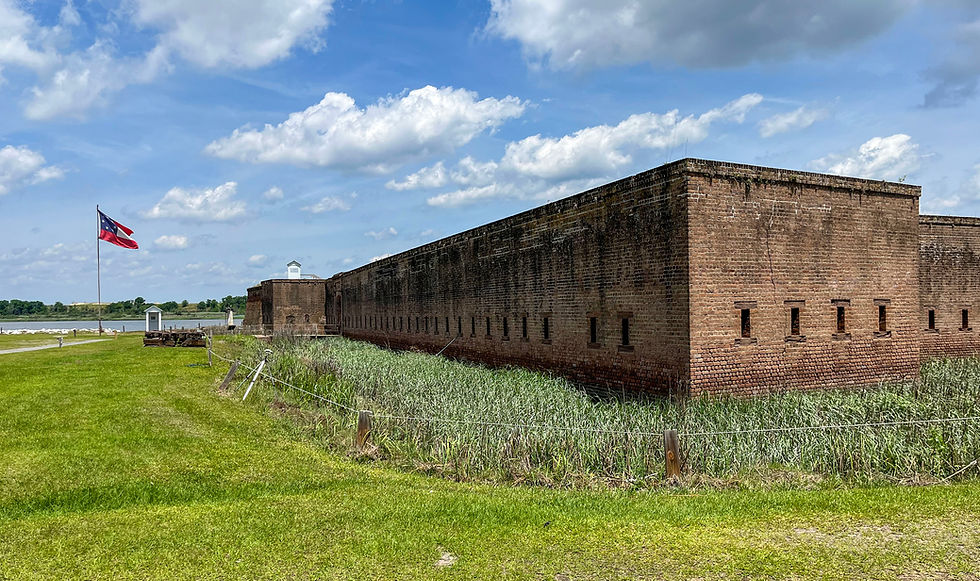Bacon's Castle
- Tim Murphy

- Mar 27, 2017
- 4 min read
Updated: Apr 24, 2021
Along the flat, coastal plains just outside of Surry, Virginia, stands Bacon's Castle. This imposing structure has stood for over 350 years and holds the title of America's oldest brick structure. Not to mention, it is the only surviving example of High Jacobean architecture in the continental US (the other two are located in Barbados). The Jacobean style was named after King James I of England (1603-25) and incorporates Renaissance motifs and other stylistic elements into English architecture. Although Jacobean style died shortly after James did over in England, it persisted for years after his death in the colonies. Bacon's Castle was built in 1665, forty years after King James I's passing, and belonged to Arthur Allen, a prosperous tobacco planter. Allen died in 1669 and granted his son, Arthur Allen II, the house in his will. Allen II was a member of the Virginia House of Burgesses and a Major in the colonial army.

At this point you may be wondering, 'Ok, this house is neat and all, but what its significance other than being old?' Well, in mid-1676, tensions between frontiersmen and the colonial government under Governor Berkeley reached its breaking point. Nathaniel Bacon and 500 other rebels amassed in front of Berkeley's Statehouse and demanded a commission from the governor to fight the Indians and expand westward. After an initial refusal, Bacon's troops seized the Statehouse and the representatives still inside. Without the proper military strength to put down the rebellion, Berkeley reluctantly signed the commission.
But the rebellion didn't stop there. It continued for nearly six months after the fact. In mid-September 1676, some of Bacon's forces seized the Allen residence and drove the family from their land. At the same time Bacon's forces attacked Virginia's colonial capital, Jamestown, and burned it to the ground. The anarchy continued until October 26, when Bacon died of dysentery outside of Gloucester, VA (Fun fact: Bacon's followers buried him in an unmarked grave that still hasn't been found to this day). After the rebel leader's untimely death, the rebellion lost steam due to poor leadership and military strategy. Recognizing a point of weakness, Berkeley ordered loyalist troops to begin an offensive and squash the rebellion. Little by little, the rebels were defeated. On December 29, loyalists forces liberated Bacon's Castle and the Allens returned home shortly after.

The home remained in the Allen family for the next 170 years until the Hankins family bought the property in 1844. While no action took place here during the Civil War, James DeWitt Hankins served as Captain of the Surry Light Artillery (CSA) and survivied the war, only to be killed in a duel against William Underwood nearly a year later. The Hankins lost the property a decade after the South surrendered, only to subsequently be bought by the Warren family, who used the building as tenant properties through the 1970s.
So there's your quick overview of the history of the house itself. If you decide to visit the property, there is plenty to explore around the grounds. The first thing that caught my eye was the 17th-century English formal garden, the oldest in North America. When the gardens are in season, they are decorated with wildflowers, hedgerows, and perennials. Around the back of the home are some old wooden farms structures. The first building is a smokehouse built in the early 19th-century. Directly behind it is an example of slave/tenant quarters. This and nearly twenty other structures like it were built in the 1820s and 1830s. Back when the Castle resided on over 1,000 acres of farm land, the family owned over 80 slaves who resided in buildings such as the one pictured. After the Civil War, these buildings were turned into tenant farm houses. Deeper on the property stand the '1701 Barn,' or Allen's Smokehouse. This structure was actually built in 1750 and smoke stains from its activity can still be seen on the house's framework. It amazes me how these wooden structures have survived nearly 300 years of existence.
After a self-guided tour outside, guests can purchase tickets to follow along with the indoor guided tour. The tour guides are exceptional and the house is full of original 17th and 18th century furniture and paintings. Some of the most interesting items on display were a Spanish Conquest book printed in the 1550s, a baby's cradle original to the house, and a 300 year-old grandfather clock. The tour concludes in the artifact room which displays some of the relics recovered from the site over the years. There are bottles, dining ware, and other miscellaneous colonial artifacts on display.

I really enjoyed my visit to Bacon's Castle. It's amazing to think that it's the oldest brick structure in America and that it's survived this long. The preservationists who take care of this property have done an exceptional job at maintaining the site's historical integrity and appearance. However, I would not plan an entire day around this site. The site is relatively small, and you can easily be done exploring in about an hour and a half. Additionally, the drive there is a little time-consuming. You can take a ferry across the James River to get there (which is really cool by the way), but it takes about 40 minutes to load, cross, and unload. The other option is to circumvent the ferry by looping down to Newport News (assuming you're coming from the North), but the time difference is insignificant. I would suggest, however, that if you make the trip to Surry, make it worth your while andpurchase a block ticket for Bacon's Castle and Smith's Fort Plantation (review coming soon!) which is about 10 minutes west of the home site. That's my take on Bacon's Castle! Thanks for reading!


























